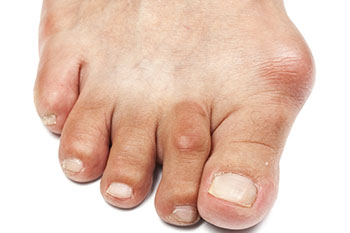
If you have arthritis, frequently wear tight fitting shoes such as high heels, and are older in age, it’s very likely that you may develop a bunion. A bony hump at the base of the big toe is the biggest sign that you may have developed this condition. Bunions are often painful and typically cause an extreme amount of discomfort. Because a bunion protrudes on the side of the foot, it’s likely for it to continuously rub against the inside of your shoe. This causes frequent friction and pain, which may cause calluses to form as well.
There are a number of ways to help alleviate discomfort if you’re experiencing pain due to having a bunion. To begin, it’s important that you maintain a healthy body weight in order to lessen the pressure put on your feet. Icing and warming the affected area may also help ease pain, as well as wearing wider-set footwear to avoid friction between your shoe and bunion. Some patients have also found shoe inserts to be extremely helpful for correcting the position of the foot. In more serious cases where the pain is severe, a podiatrist may recommend surgery for treating the bunion.
If you would like more information on how to best treat your bunion, we recommend you consult with a podiatrist as soon as possible for professional care and a proper diagnosis.
Condition:
A bunion is generally considered an enlargement of the joint (a lump of bone) at the base and side of the big toe (specifically, the first metatarsal-phalangeal joint). Bunions form when the toe moves out of place. As the big toe bends towards the others this lump becomes larger and the bunion can become painful – arthritis and stiffness can eventually develop.
Symptoms:
Many people with bunions suffer from discomfort and pain from the constant irritation, rubbing and friction of the enlargement against shoes. The skin over the toe becomes red and tender. Because this joint flexes with every step, the bigger the bunion gets, the more it hurts to walk. Over time, bursitis or arthritis may set in, the skin on the bottom of the foot may become thicker, and everyday walking may become difficult—all contributing to chronic pain.
Treatment:
Bunions can be treated with wider shoes, pads, splints and orthosis. These all help to reduce the symptoms but they don’t “get rid” of the condition. Since bunions are a bone deformity, they do not resolve by themselves. The goal for bunion treatment is to relieve the pressure and pain caused by irritations and, second, to stop any progressive growth of the enlargement.
Surgical Treatment
Most bunion surgery is performed when conservative measures have been exhausted by the patient and pain persists which is usually the case when patients seek care for their bunions. The surgery is performed on an outpatient basis. There are now various ways to approach correction. In general and traditionally, an incision is placed over the first metatarsal bone. Once the bone is exposed, the bump is removed. An osteotomy is performed in order to move the bone inward towards the second metatarsal. Pins, screws or other hardware can be used to stabilize the osteotomy.
Recovery for bunion surgery is approximately six to eight weeks in most cases, however, there is the possibility of complications as with any surgery which could delay healing. For example, some people have less mineralization of their bone which could delay healing at 6-8 weeks. Often times you are able to walk immediately following surgery. Walking is done in protective shoes or boots with or without use of crutches. Physical therapy is used to increase mobility after surgery.
Prevention:
Wearing shoes that are too tight is the leading cause of bunions. Bunions can be hereditary and do tend to run in families, usually because of various disorders of foot structure. Foot injuries, neuromuscular problems, flat feet and pronated feet can contribute to their formation.



